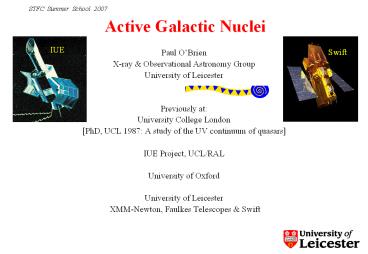Paul O - PowerPoint PPT Presentation
Title: Paul O
1
Active Galactic Nuclei
IUE
- Paul OBrien
- X-ray Observational Astronomy Group
- University of Leicester
- Previously at
- University College London
- PhD, UCL 1987 A study of the UV continuum of
quasars - IUE Project, UCL/RAL
- University of Oxford
- University of Leicester
- XMM-Newton, Faulkes Telescopes Swift
Swift
2
Active Galactic Nuclei
- A little history
- Taxonomy (split them up)
- Unification (join them together again)
- Mass, size and structure
Radio mm IR Opt./UV X-ray
AGN an object with nuclear, non-stellar
energetic phenomena. Power-source accretion disc
feeding a massive black hole. But why, when,
where, how?
3
History lesson start (almost) at the beginning
PhD student goes here
Leviathan, 1845, 1.8m telescope! Birr Castle,
Parsonstown, Eire (wet) Owned by Lord Rosse
(optimist)
M51 example of a spiral nebula
4
The first galaxy/AGN spectra
- Photography improved (dry plates) by late 1800s
so could be used in a spectrograph ? stellar
spectral classification (Pickering, Cannon etc.).
- Sir William Huggins, 1864 spectroscopy of M31
(Andromeda). Saw (faint) absorption lines but
unsure if they were reflected Moon-light - Edward Fath, 1909 PhD displayed nebulae
spectra showing that galaxies look like stars
i.e. galaxies are made out of stars! - But, also found a galaxy (in 1908) that had
bright lines in its spectrum, has also a strong
continuous spectrum which contains absorption
lines. - Object NGC1068 (M77) the first AGN!
5
- Seyfert Galaxies
- Fath followed by Slipher (M31 velocity), and
Hubble(?fame, fortune?, telescope) - Carl Seyfert (1943) Postdoc at Mount Wilson
- Isolated 6 spiral galaxies with blue nuclei which
show high-ionization emission lines much wider
than absorption lines in normal galaxies. - Two basic types
- Seyfert 1 - broad permitted lines narrow
forbidden lines - Seyfert 2 - narrow permitted and forbidden
lines
H? OIII
6
Example Seyfert spectra
H?
H?
Blue continuum Red continuum
Wavelength (Å)
7
NGC 3783
Seyfert Type 1
See a large range in ionization species (too
large for normal nebulae)
8
M87VLA
- Radio Galaxies
- Discovered after WWII (Ryle, Mills etc.)
- Example M87 (NGC4486). Identified by Bolton,
Stanley Slee (1949). Optical jet found by
Curtis in 1918 - Radio emission is non-thermal (Synchrotron.
Inverse Compton)
- Quasars/QSOs
- 3C273 (Mararten Schmidt 1963).
- High redshift (0.158) implied huge luminosity.
Also variable ? small size - Most (90) are radio-quiet (QSOs).
- Quasars found in elliptical galaxies.
- QSOs found in either spirals or ellipticals.
M87 optical
9
The Host Galaxy and the AGN
galaxies at same redshift
Disturbed morphology Interaction?
10
Need to explain the diverse properties of AGN
- AGN can be very luminous (1000x bright galaxies)
- The continuum varies on (fairly) short timescale
?small objects - Broad-band continuum wide range in emission
line ionisation - See both broad (?10000 km s-1) and narrow
(?2000 km s-1) emission lines. The narrow lines
are broader than normal galactic lines. - Solution the accreting supermassive black hole
(SMBH) model
11
AGN Type 1 and 2 Unification
Size-scales Black-hole
Rs 3x109 M6 m Accretion disc
3 104 Rs Broad Line Region 1-100
light-days Molecular Torus 1-10
light-years
12
Type 2 AGN
Type 1 AGN
Obscuring stuff
Radio loud AGN
13
Black holes in every galaxy?
M87 ionized gas rotation curve. Large dark
mass required (109 M?) Virial theorem M ?(r ?V
2 /G)
Magorrian et al. 1998
14
MBH-? relationship
Peterson et al.
Calibrate AGN method vs. stellar (Ferrarese). AGN
follow same relation as in-active galaxies.
Bulge mass correlates with mass of SMBH
15
PDS 456 the most powerful object in the local
Universe, but unknown until 1997
QSO Luminosity vs. redshift
Nearby galaxies Interaction?
At z0.184, 1'' 3.1 kpc
Torres et al. (1997) Yun et al. (2004)
16
X-ray and UV observations of PDS 456
PDS456 3C273
Massive absorption
X-ray spectrum requires a massive, highly-ionized
outflow moving at 0.15c . Also see fast outflow
in the UV. Outflow mass-loss rate 10 M? yr-1
For 10 covering factor, outflow K.E. 1039 J
s-1 (10 Lbol) (Reeves et al. 2003 OBrien et
al. 2005)
17
What could outflows mean the concept of
feedback
- Some outflows have a K.E. comparable to the
radiation luminosity are they common in the
early Universe? - Most SMBH mass probably assembled by luminous
accretion. So perhaps built when the accretion
rate is high/spin low? - Over 107 years X-ray outflows could deposit a
total mechanical energy comparable to the binding
energy of a Galactic bulge (1052 J). - Feedback between outflows and star formation??
18
Interaction in actionthe Ultraluminous IR
Galaxies
IRAS revealed a large population of
Ultraluminous IR Galaxies. Star-formation rate
100-1000 xGalactic. Most are interacting or
highly disturbed. SMBHs (and galaxies?) grow
through accretion, SF, outflows all driven by
mergers, shocks, galactic bars etc.
19
How do we see into the heart of an AGN ? Try
radio interferometry e.g. M87 , only 18Mpc away
(1" 300 light-years)
But, we need to look in the optical/IR
20
Optical interferometry
VLTI 4x8.2m 4x1.8m Baselines up to 200m,
10mas
Creech-Eakman et al. 2006
Magdalena Ridge Observatory, NM 10 x 1.4m
optical/IR telescopes with baselines up to 340m.
On schedule for 2008/2009 start. Observe from
0.6-2.4 microns with spatial scale of 0.3-30 mas.
21
AGN The Future
- More data of all kinds better models
- Deep surveys in sub-mm, IR, X-ray, etc. to find
all the AGN - High-resolution imaging in radio, optical, IR
(e.g. SKA, VLTI, MRO)
Time-dependent, 3-D, MHD disc(torus) simulation
(Hawley et al.) UK astronomers have UKAFF the
UK Astrophysics Fluids Facility at Leicester
build your own disc, jet, black hole Have fun!
22
The end































